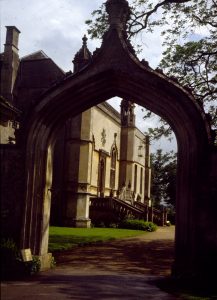 Two abbeys play a role in Effigy of the Cloven Hoof, the first novel in the Lady Apollonia West Country Mystery Series. In a flash-back after the trauma of her first marriage, my heroine desperately needed spiritual healing. She sought out the help of her friend, the abbess of the nunnery at Lacock Abbey in Wiltshire hoping to recover balance in her life. Eventually she is able through meditation and reading The Revelations of Divine Love by Mother Julian of Norwich, to be restored. She leaves Lacock Abbey and marries her second, most beloved husband, Edward of Aust, establishing Aust as her home for the rest of her life. Lacock Abbey had been founded in the early 13th century as an Augustinian nunnery and generally prospered until the Dissolution by King Henry VIII.
Two abbeys play a role in Effigy of the Cloven Hoof, the first novel in the Lady Apollonia West Country Mystery Series. In a flash-back after the trauma of her first marriage, my heroine desperately needed spiritual healing. She sought out the help of her friend, the abbess of the nunnery at Lacock Abbey in Wiltshire hoping to recover balance in her life. Eventually she is able through meditation and reading The Revelations of Divine Love by Mother Julian of Norwich, to be restored. She leaves Lacock Abbey and marries her second, most beloved husband, Edward of Aust, establishing Aust as her home for the rest of her life. Lacock Abbey had been founded in the early 13th century as an Augustinian nunnery and generally prospered until the Dissolution by King Henry VIII.
Kingswood Abbey in Gloucester appears early in the story as the monastery where a decapitated body, discovered near Aust, can be taken until its mysterious death can be solved. In the epilogue of my book, Lady Apollonia sends Brandon Landow, the pardoner, on a surprise mission to the egregious Abbot of Kingswood. Kingswood was a Cistercian abbey that was struggling in the 14th century after significant losses at the time of the bubonic plague, well before the Dissolution of the Monasteries by King Henry VIII.
Only fragments of these abbeys have survived, but there is more worth seeing at Lacock. Both the village and the abbey are maintained by the National Trust. The abbey was sold at the Dissolution, and the church and some buildings were destroyed. The present house, however, was built over the medieval cloisters and chapter house and can be visited. Some other fragments such as the Brewhouse and Bakehouse remain. The Fox Talbot Museum is located at Lacock Abbey, honouring the pioneering work of William Talbot of Lacock where he shot the first picture ever taken with a camera in 1836. An entrance gate is pictured above.
Only the gatehouse remains at Kingswood Abbey, now run by English Heritage. Kingswood’s abbot turned down the chance to house the tomb of King Edward II in the abbey church after the royal death. It went instead to Saint Mary’s Abbey in Gloucester and became an important place of pilgrimage, significantly enriching the church in Gloucester. Kingswood’s missed opportunity plays a role in my story.
For more information on Lacock Abbey, click on
https://en.wikipedia.org/wiki/Lacock_Abbey .
For more information on Kingswood Abbey, click on
https://en.wikipedia.org/wiki/Kingswood_Abbey ,
or on http://www.british-history.ac.uk/vch/glos/vol2/pp99-101
or on http://www2.glos.ac.uk/bgas/tbgas/v073/bg073115.pdf .
Tags: Chaucer's England, historical fiction, medieval mysteries